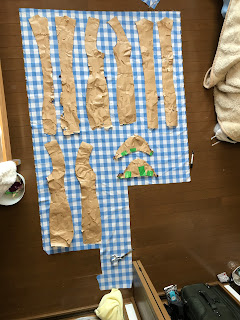 |
| Make sure your completed piece crosses left-over-right. It's important. |
I assume you're here for the pattern. Let's get to that first, and then we'll talk backstory. This pattern works for split-top style tissue packs and top-pull tissue packs, as long as the dimensions are equal to or smaller than 8 x 12 x 2 cm.
I created this pattern from a photo I took a while ago. If you have another pattern, or if you have suggestions for improving this one, please comment below.
The pattern
Materials needed
Lightweight woven fabric, at least 30 x 20 cm
Contrast lightweight woven fabric for the collar, at least 4 x 36 cm
Usual sewing supplies (iron, thread, etc.)
Instructions
Cutting
Cut out all pieces as shown in the photo below, all units are in centimeters, 1 cm seam allowance is already included, collar measures 36 x 4 cm:
 |
| Cutting guide for tissue cover pieces |
Assembly
Generally, sew front pieces together, attach to the back at the shoulder, add the collar, then sew the side and bottom seams.
Now for all of that, with pictures:
With wrong sides facing out, sew middle cross pieces to the side pieces, aligning the bottom edge.
 |
| Middle cross pieces sewn to front side pieces |
With wrong sides facing out, attach at the "shoulders"
 |
| "Shoulders" attached, preparing to attach the collar |
With wrong sides facing out, attach collar, beginning at left cross edge (Note that collar edge does not meet on the right. This is intentional, but you can add an extra cm if you want the edges to meet):
 |
| Collar attached, then remaining edge was turned under twice and pressed |
Hand sew the collar's free edge to the inside of the kimono, or stitch-in-the-ditch (with the correct side of the fabric up, sew between the collar and fabric seam to secure the collar's free edge). I sewed by hand because I like the look so much more, and the piece is small enough that it didn't take very long.
Match the side and bottom edges with wrong sides facing out. Sew.
 |
| Free edge of collar is stitched down. Sides and bottom edge are sewn. |
Trim seams and turn piece right-side out. Press and stuff with tissue pack. Done!!
The backstory
I was in Hitachiota, Ibaraki during the Hinamatsuri festival. The shops go all-out with their decorations for Girl's Day, and there are lots and lots of handmade items on display. An especially common theme are paired items representing an emperor and empress. There were lots of cute designs, but I really liked the charm and practicality of this tissue cover:
 |
| The tissue cover that started it all for me |
I should have bought it. I don't know why I didn't. It would have been much easier to develop a pattern with an actual product in front of me, but ah, well. Live and learn. Honestly, I still like theirs better, so I'll probably fiddle with the pattern a little more, hoping to get it just right.
If you decide to make one, here are a few things to keep in mind: kimono are always worn with the left side crossing over the right, except when a person who has died is lying in state. Then the kimono is crossed right-over-left. It's a little detail, but it is very important. Also, patterns and colors are different for men and women. For women it's usually red and/or ornate patterns, and for men it's muted colors or black or blue. Not always, but usually. Of course, you could always throw caution to the wind and make it however you like. Creativity is highly encouraged, as are pictures! ;-)








































